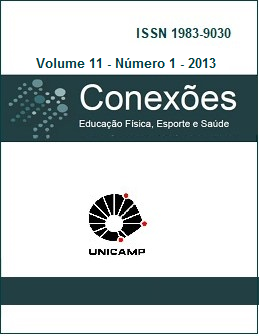Abstract
The trials of canoeing slalom are characterized by high intensity descents in rivers form.
High values of heart rate (HR) are observed in this sport. However, data about HR
variability (HRV) and effects of training in this parameter not yet been investigated. In this
way, the aim of the present study was analyze form the HRV of slalom kayakers, the
effects of seven weeks of training monitored in the HR autonomic modulation. Six
kayakers were evaluated before and after seven weeks of training. The HR and the R-R
intervals were obtained by 15 minutes, with the athletes at rest in sitting posture. The HRV
was analyzed in the time domain. The training was performed in six weekly sessions of 2
h/day approximately. The values obtained shows parasympathetic predominance in
kayaker HR modulation without significant differences between the HRV indices. The
training monitoring show that just the 3ª week of training show high values when
compared to the others, being the HRV not changed in this period. Accordingly whit the
results, the slalom kayakers shows parasympathetic predominance relative to autonomic
modulation of HR, which is not modified after seven weeks of training.
References
MANCHADO-GOBATTO, F. B. et al. Critical velocity and anaerobic work capacity of slalom kayak athletes: effects of 8-weeks of specific training. In: ANNUAL CONGRESS OF THE EUROPEAN COLLEGE OF SPORT SCIENCE, 15., 2010. Book of Abstracts…2010.
MICHAEL, J. S.; SMITH, R.; ROONEY, K. B. Determinants of kayak paddling performance. Sports Biomechics, Abngdon, v. 8 , n.2 , p. 167-179, 2009.
LAURSEN, P. B. Training for intense exercise performance: high-intensity or high-volume training?. Scandinavian Journal of Medicine and Science in Sports, p.1-10, sept. 2010.
ACHTEN, J.; JEUKENDRUP, A. E. Heart rate monitoring: applications and limitations. Sports Medicine, Auckland, v. 33, p. 517-538, jan. 2003.
LHUISSIER, J. F. et al. Ventilatory and cardiac responses to hypoxia at submaximal exercise are independent of altitude and exercise intensity. Journal of Applied Physiology, Bethesda, p. 566-570, 2012.
EARNEST , C, P., BLAIR, S, N., CHURCH, T, S. Heart rate variability and exercise in aging women. Journal of Women’s Health, v. 21, 2012.
ASLANI, A., ASLANI, A., KHEIRKHAH, J., SOBHANI, V. Cardio-pulmonary fitness test by ultra-short hear rate variability. Journal of Cardiovascular Disease Research, v. 2, 2012.
PAIVA, V, C. et al. Comparison of assessment methods of cardiac vagal modulation. Arquivos Brasileiros de Cardiologia, São Paulo, p. 493-501, 2011.
PERINI, R.; VEICSTEINAS, A. Heart rate variability and autonomic activity at rest and during exercise in various physiological conditions. European Journal of Applied Physiology, Heidelberg, p. 317-325, 2003.
AUBERT, A, E.; SEPS, B.; BECKERS, F. Heart rate variability in athletes. Sports Medicine, Auckland, v. 33, p. 889-919, dez. 2003.
YU, S. et al. Research in Sports Medicine. v. 18 , p. 263-269, nov. 2010.
BUCHHEIT, A. et al. Effect of maturation on hemodynamic and autonomic control recovery following maximal running exercise in higly trained young soccer players. Frontiers in Physiology, v. 2, p 1-13, oct. 2011.
KAIKKONEN, P. et al. Heart rate variability is related to training load variables in interval running exercises. European Journal of Applied Physiology, Heidelberg, jun. 2011.
VESTERINEN, V. et al. Heart rate variability in prediction of individual adaptation to endurance training in recreational endurance runners. Scandinavian Journal of Medicine and Science in Sports, ago. 2011.
PARRADO, E. et al. Perceived tiredness and heart rate variability in relation to overload during a field hockey Wold Cup. Perceptual Motor Skills, Missoula, v.110, p. 699-713, jun. 2010.
LUNT, H, C. et al. Cycling cadence affects heart rate variability. Physiological Measurement, p. 1133-1145, 2011.
MAZON, J. et al. Effects of training periodization on cardiac autonomic modulation and endogenous stress markers in volleyball players. Scandinavian Journal Medicine Science in Sports, 2011.
FOSTER, C. et al. A new approach to monitoring exercise training. Journal of Strength Conditioning Research, Colorado Springs, v.15 , n.1, p.109-115, 2001.
KATONA, P. G. et al. Sympathetic and parasympathetic cardiac control in athletes and nonathletes at rest. Journal of Applied Physiology: respirat environ exercise physiology, v. 52, n. 6, p. 1652-1657, 1982.
CRUZ-FILHO, F. E. S.; MAIA, I. G. Eletrofisiologia clínica e intervencionista das arritmias cardíacas. Rio de Janeiro: Revinter, 1997. p.18-40.
ALMEIDA, M. B.; ARAÚJO, C. G. S. Effects of aerobic training on heart rate. Revista Brasileira de Medicina do Esporte, São Paulo, v. 9, n. 2, p. 113-120, 2003.
BOUTCHER, S.H. High-intensity intermittent exercise and fat loss. Journal of Obesity, v. 2011, p. 1-10, 2010.
BORRESEN, J.; LAMBET, M. I. The quantification of training load, the training response and the effect on performance. Sports Medicine, Auckland, v. 39, n. 9, p. 779-795, 2009.
The Conexões: Educação Física, Esporte e Saúde Journal uses the license of Creative Commons (CC), thus preserving the integrity of articles in an open access environment.


